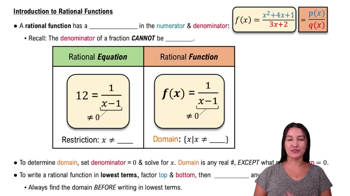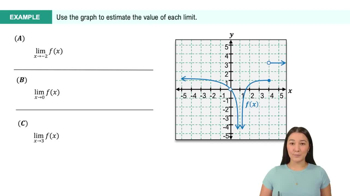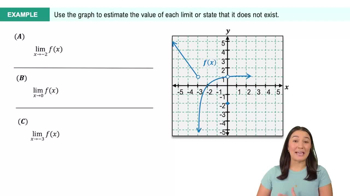Table of contents
- 0. Functions7h 52m
- Introduction to Functions16m
- Piecewise Functions10m
- Properties of Functions9m
- Common Functions1h 8m
- Transformations5m
- Combining Functions27m
- Exponent rules32m
- Exponential Functions28m
- Logarithmic Functions24m
- Properties of Logarithms34m
- Exponential & Logarithmic Equations35m
- Introduction to Trigonometric Functions38m
- Graphs of Trigonometric Functions44m
- Trigonometric Identities47m
- Inverse Trigonometric Functions48m
- 1. Limits and Continuity2h 2m
- 2. Intro to Derivatives1h 33m
- 3. Techniques of Differentiation3h 18m
- 4. Applications of Derivatives2h 38m
- 5. Graphical Applications of Derivatives6h 2m
- 6. Derivatives of Inverse, Exponential, & Logarithmic Functions2h 37m
- 7. Antiderivatives & Indefinite Integrals1h 26m
- 8. Definite Integrals4h 44m
- 9. Graphical Applications of Integrals2h 27m
- 10. Physics Applications of Integrals 2h 22m
1. Limits and Continuity
Introduction to Limits
Problem 4.3.111a
Textbook Question
Population models The population of a species is given by the function P(t) = Kt²/(t² + b) , where t ≥ 0 is measured in years and K and b are positive real numbers.
a. With K = 300 and b = 30, what is lim_t→∞ P(t), the carrying capacity of the population?
 Verified step by step guidance
Verified step by step guidance1
First, understand the concept of carrying capacity in population models. It refers to the maximum population size that the environment can sustain indefinitely.
To find the carrying capacity, we need to evaluate the limit of the function P(t) as t approaches infinity. This involves analyzing the behavior of the function as t becomes very large.
The function given is P(t) = \( \frac{Kt^2}{t^2 + b} \). Substitute K = 300 and b = 30 into the function, resulting in P(t) = \( \frac{300t^2}{t^2 + 30} \).
To find \( \lim_{t \to \infty} P(t) \), divide both the numerator and the denominator by \( t^2 \), the highest power of t in the expression. This simplifies the function to \( \frac{300}{1 + \frac{30}{t^2}} \).
As t approaches infinity, \( \frac{30}{t^2} \) approaches 0, simplifying the expression to \( \frac{300}{1} \). Therefore, the limit is 300, which is the carrying capacity of the population.
 Verified video answer for a similar problem:
Verified video answer for a similar problem:This video solution was recommended by our tutors as helpful for the problem above
Video duration:
2mPlay a video:
Was this helpful?
Key Concepts
Here are the essential concepts you must grasp in order to answer the question correctly.
Limits
In calculus, a limit describes the behavior of a function as its input approaches a certain value. It is essential for understanding how functions behave at boundaries or at infinity. In this context, evaluating the limit as t approaches infinity helps determine the long-term behavior of the population model.
Recommended video:

One-Sided Limits
Carrying Capacity
Carrying capacity refers to the maximum population size that an environment can sustain indefinitely without being degraded. In population models, it is often represented as the limit of the population function as time approaches infinity, indicating the population's equilibrium state under given conditions.
Recommended video:

Intro to the Chain Rule Example 2
Rational Functions
A rational function is a ratio of two polynomials. In the given population model, P(t) is a rational function where the numerator and denominator are both polynomials in t. Understanding the behavior of rational functions, particularly their limits at infinity, is crucial for analyzing population dynamics in this context.
Recommended video:

Intro to Rational Functions

 6:47m
6:47mWatch next
Master Finding Limits Numerically and Graphically with a bite sized video explanation from Callie
Start learning




